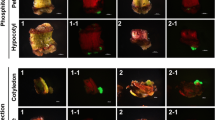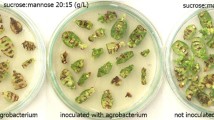Summary
Selectable marker genes play an important role in plant transformation. The level of selection pressure is generally established by generating a kill curve for the selectable marker. In most cases, the lowest concentration which kills all explants is used. This study examined two selectable marker genes, phosphinothricin acetyl transferase (PAT) and hygromycin phosphotransferase (HPT), in transformation of tobacco leaf disks. Experiments to determine the lethal level of the herbicide, glufosinate-ammonium (phosphinothricin) (PPT) using a leaf-disk regeneration assay established that no shoots regenerated at 2 to 4 mg PPT per 1. Likewise with the antibiotic, hygromycin (HYG), no plants regenerated at 50 mg hygromycin per 1. In contrast, after cocultivation of the leaf disks withAgrobacterium tumefaciens containing either the PAT or HPT gene in combination with a Bt gene for insect resistance, plants were successfully regenerated from leaf disks at 2 to 4 mg PPT per 1 and 50 mg hygromycin per 1. However, most plants regenerated at 2 and 3 mg PPT per 1 were found to be nontransformed (95–100% escapes) by i) Southern-blot analysis, ii) herbicide application test, and iii) insect feeding bioassay. On the other hand, plants that regenerated on 50 mg hygromycin per 1 and 4 mg PPT per 1 were transgenic as determined by Southern analysis, leaf assay for PPT or HYG resistance, and death of tobacco budworms feeding on these leaves. This study showed a significant level of cross-protection and/or transient expression of the PAT selectable marker gene allowing escapes (95–100%) at selection levels of 2 and 3 mg PPT per 1 which completely kill controls. On the other hand, the HPT gene at 50 mg is efficient in selecting for T-DNA integration.
Similar content being viewed by others
References
Cao, J.; Duan, X.; McElroy, D., et al. Regeneration of herbicide resistant transgenic rice plants following microprojectile-mediated transformation of suspension culture cells. Plant Cell Rep. 11:586–591; 1992.
Christou, P.; Ford, T. L.; Kofron, M. Production of transgenic rice (Oryza sativa L.) plants from agronomically important indica, and japonica varieties via electric discharge particle acceleration of exogenous DNA into immature zygotic embryos. Bio/Technology 9:957–962; 1991.
Deblaere, R.; Reynaerts, A.; Hofte, H., et al. Vectors for cloning in plant cells. Methods Enzymol. 153:277–292; 1987.
DeBlock, M.; Botterman, J.; Vandewiele, M., et al. Engineering herbicide resistance in plants by expression of a detoxifying enzyme. EMBO 6:2513–2518; 1987.
Dekeyser, R.; Claes, B.; Marichal, M., et al. Evaluation of selectable markers for rice transformation. Plant Physiol. 90:217–223; 1989.
Dellaporta, S. L.; Wood, J.; Hicks, J. B. A plant DNA minipreparation: Version II. Plant Mol. Biol. Rep. 1:19–21; 1983.
Hiei, Y.; Ohta, S.; Komari, T., et al. Efficient transformation of rice (Oryza sativa L.) mediated byAgrobacterium and sequence analysis of boundaries of the T-DNA. Plant J. 6:271–282; 1984.
Horsch, R. B.; Fry, J.; Hoffmann, N. L., et al. A simple and general method for transferring genes into plants. Science 227:1229–1231; 1985.
Ingelbrecht, I.; VanHoudt, H.; Van Montagu, M., et al. Posttranscriptional silencing of reporter transgenes in tobacco correlates with DNA methylation. Proc. Natl. Acad. Sci. USA 91:10502–10506; 1994.
Klee, H.; Horsch, R. B.; Rogers, S. G.Agrobacterium-mediated plant transformation and its further applications to plant biology. Annu. Rev. Plant Physiol. 38:467–486; 1987.
Murashige, T.; Skoog, F. A revised medium for rapid growth and bioassays with tobacco tissue cultures. Physiol. Plant. 15:473–497; 1962.
Ortiz, J. P. A.; Reggiardo, M. I.; Ravizzini, R. A., et al. Hygromycin resistance as an efficient selectable marker for wheat stable transformation. Plant Cell Rep. 15:877–881; 1996.
Park, S. H.; Pinson, S. R. M.; Smith, R. H. T-DNA integration into genomic DNA of rice followingAgrobacterium inoculation of isolated shoot apices. Plant Mol. Biol. 32:1135–1148; 1996.
Wan, Y.; Lemaux, P. G. Generation of large numbers of independently transformed fertile barley plants. Plant Physiol. 104:37–48; 1994.
Author information
Authors and Affiliations
Rights and permissions
About this article
Cite this article
Park, S.H., Rose, S.C., Zapata, C. et al. Cross-protection and selectable marker genes in plant transformation. In Vitro Cell.Dev.Biol.-Plant 34, 117–121 (1998). https://doi.org/10.1007/BF02822775
Received:
Accepted:
Issue Date:
DOI: https://doi.org/10.1007/BF02822775




